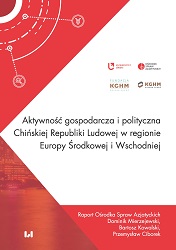Aktywność gospodarcza i polityczna Chińskiej Republiki Ludowej w regionie Europy Środkowej i Wschodniej
Economic and Political Activity of the People's Republic of China in the Region of Central and Eastern Europe
Author(s): Dominik Mierzejewski, Bartosz Kowalski, Przemysław Ciborek
Subject(s): Politics / Political Sciences, Politics, Economy, National Economy
Published by: Wydawnictwo Uniwersytetu Łódzkiego
Keywords: state partnerships;economic policy of the PRC;economic relations between the PRC and Europe;the PRC
Summary/Abstract: Conclusion
1. The goal of the 16+1 format is to create leaders of co-operation with China in the region and to define models of economic co-operation at the bilateral level;
2. The basic problem pivots around the perception of actors from Central and Eastern Europe (CEE) in terms of the global South, which in the case of the Visegrad Group member countries does not correspond to the current reality;
3. The perception indicated above creates the mechanisms of Chinese economic actions, including investments in developing countries. This particularly applies to the non-EU 16+1 members, i.e. the Western Balkans, where most of the investments are financed by the Chinese Exim Bank;
4. The actions of Hungary and Serbia correspond to their political and economic aspirations, and also create the foundations for leadership in the region in a broader, not merely Chinese context;
5. The division of labour in the 16+1 format has been based on the choice of the CEE countries so as to use the competitive advantages of each country in the best possible way in economic relations with China. In this regard, the outline of the division of labour is similar in outline to the past co-operation format of the Council for Mutual Economic Assistance (Comecon);
6. The Chinese action in the 16+1 format is considered a process of testing various models of economic co-operation. In some format countries, including Bulgaria and the Czech Republic, they turned out to be incompatible with European reality;
7. The 16+1 format overlaps with other initiatives on the North–South axis, such as co-operation within the framework of the Three Seas Initiative or Via Carpathia route;
8. The state of relations of selected CEE countries with China and China's future actions in the region is influenced by three main factors: (a) the state of relations with Russia and the EU, (b) the population of the Chinese diaspora, (c) public opinion on China;
9. A sense of disappointment predominates among selected 16+1 countries in their evaluation of the effects of co-operation with China so far: a low investment volume and a growing foreign trade deficit.
- Print-ISBN-13: 978-83-8142-364-9
- Page Count: 56
- Publication Year: 2018
- Language: Polish
- eBook-PDF
- Table of Content

